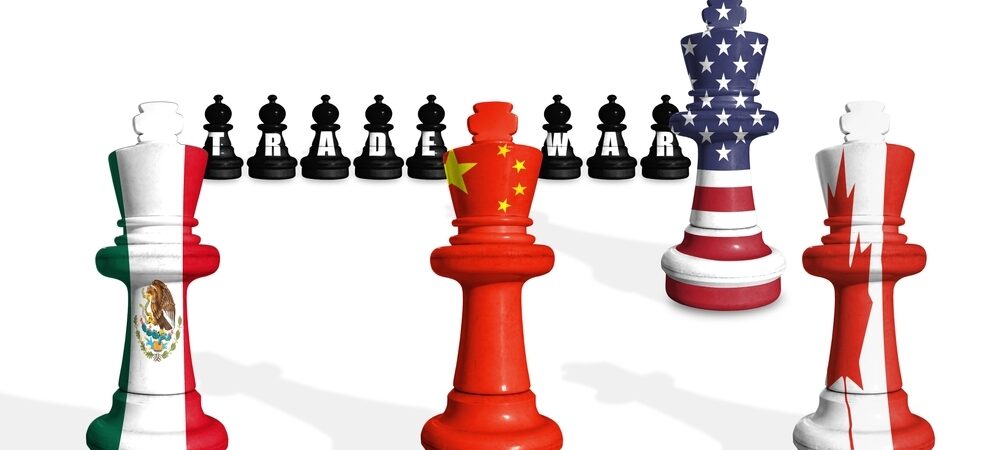Trade retaliation looms from Canada, China, Mexico, and the European Union in response to U.S. tariffs. Four timelines lay out their responses, and the experience of American soybean farmers in 2018 shows how damaging this could be.
In response to the Donald Trump administration’s second-term tariffs, Canada, China, Mexico, and the European Union (EU)—the United States’ largest trade partners—have announced or threatened retaliatory tariffs.
How do retaliatory tariffs work?
A tariff is a tax on foreign-made goods, which makes them more expensive to import. To get a better idea of how retaliatory tariffs could affect the United States, let’s look at what happened to American soybean farmers during Trump’s first term. Soybeans are the United States’ largest agricultural export to China.
In 2017, U.S. soybean exports to China totaled $12 billion, near an all-time high. Then in 2018, the United States placed tariffs on $34 billion worth of Chinese non-agricultural goods, and China retaliated with tariffs on U.S. soybeans and other products. Soybean exports to China plummeted, with U.S. farmers suffering substantial losses.
U.S. farmers’ losses were Brazilian farmers’ gains. Brazil, the world’s leading soybean producer, increased soybean exports to China and has remained its top supplier.
U.S. soybean exports to China recovered after the two countries signed a trade deal in 2020 but have declined somewhat in recent years as China has sought to become less reliant on imported soy.
From 2018 to 2019, U.S. farmers suffered $26 billion in losses due to China’s retaliatory tariffs. In response, the Trump administration provided $28 billion in bailouts to farmers across the two years.
How are countries retaliating against Trump’s 2025 tariffs?
The second Trump administration has largely taken a blanket approach with tariffs, initially targeting all goods from Canada, China, and Mexico, as well as all aluminum and steel imports, and planning reciprocal tariffs on all trade partners. U.S. trade partners, meanwhile, have taken a more targeted approach aimed at specific U.S. products.
Canada
On March 4, Canada imposed tariffs on U.S. imports including agricultural goods, appliances, motorcycles, apparel, certain paper products, and footwear. In response to Trump waiving tariffs for Canadian imports covered under the U.S.-Mexico-Canada Agreement (USMCA), Canada delayed a second round of tariffs on goods ranging from agricultural and aerospace products to electric vehicles until April 2.
On March 10, the Canadian province of Ontario imposed a surcharge on electricity exported to Michigan, Minnesota, and New York, but later suspended this. However, in response to U.S. tariffs on aluminum and steel imports, Canada on March 12 announced additional tariffs on those two U.S. metals, as well as other goods.
China
China has also imposed retaliatory tariffs on the United States. The first round went into effect on February 10, affecting coal, liquefied natural gas, crude oil, agricultural machinery, large vehicles, and pickup trucks. After Trump increased tariffs on China in early March, Beijing announced a second round of tariffs starting March 10; this included 10 percent tariffs on chicken, wheat, corn, and cotton products, as well as 15 percent tariffs on a range of agricultural products, including soybeans.
In addition, China has enacted export controls on critical minerals, launched an antitrust investigation into Google, and added more than a dozen U.S. companies to their Export Control and Unreliable Entity lists. These measures will not only have the potential to disrupt U.S. supply chains but also harm the global economic competitiveness of U.S. businesses.
European Union
Likewise, the EU has stated that “unjustified” U.S. tariffs on European aluminum and steel “will not go unanswered,” and announced retaliatory tariffs on March 11. Specifically, the bloc plans to reimpose 2018 and 2020 retaliatory tariffs against the United States but also put into place new tariffs following discussions among EU member states in March.
Mexico
Mexico, meanwhile, planned on announcing retaliatory tariffs on March 9, but did not follow through after Trump exempted Mexican goods covered by the USMCA. On March 9, President Claudia Sheinbaum affirmed Mexico’s commitment to curb fentanyl trafficking and said she expects the United States to continue preventing arms trafficking into Mexican territory. If Mexico does choose to implement retaliatory tariffs—particularly after the exemption on USMCA goods expires on April 2—it is likely that they will target U.S. products such as vegetables, fruits, beer, and spirits.
Many of these retaliatory tariffs are targeting industries in parts of the country that supported Trump in the 2024 election, a move that some experts say is designed to maximize leverage. Examples include Canadian tariffs on fruit from Florida and motorcycles and coffee from Pennsylvania, and Chinese tariffs that will affect farming and manufacturing communities in the Midwest and Rust Belt. Ultimately, however, the economic cost will be felt throughout the country.
How could these retaliatory tariffs hurt the United States?
U.S. exports, specifically from the agriculture and livestock sectors, will decline in the short term as trade partners reduce their imports. U.S. producers will suffer from decreased revenue—as U.S. soybean farmers did during the 2018–19 trade war—while other countries will seek to fill the gap left by the United States. Soybean farmers have still not fully regained their market share of soybean exports to China.
Retaliatory tariffs could also result in an escalation of existing U.S. tariffs, hurting consumers as businesses pass on the costs of tariffs in the form of higher prices. The average U.S. household is already expected to face a cost increase of more than $1,200 per year as a result of existing U.S. tariffs. The imposition of retaliatory tariffs also raises other concerns, including the potential effects on the U.S. stock market and allies’ declining trust in U.S. economic leadership.
To read the article as it was published on the Council on Foreign Relations website, please click here.

